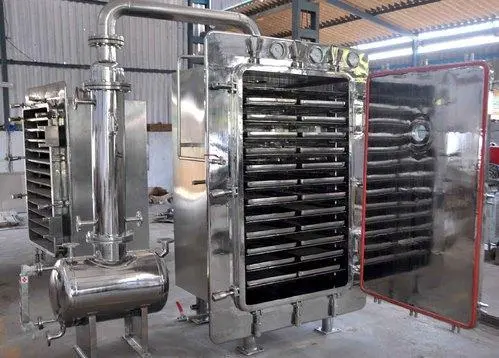-
-
(+91) 987 909 1953
(+91) 846 040 4010
Vacuum tray Dryer
Vacuum tray Dryer Machine
Vacuum Tray Dryer
Vacuum Tray Dryer works under vacuum conditions on the conduction principle. Inside the dryer are several shelves having trays on which the products are placed. The top most shelf is a dummy shelf placed there to ensure proper heating and to prevent the dried powder from escaping into the solvent extraction system. The shelves are constructed hollow with baffles cum stiffeners placed in between shelves. Every shelf has an inlet and outlet nozzle and is connected to an inlet and outlet header through these nozzles.
A hot medium reaches the shelf through the inlet header and flows through the shelves in a uniformly zig-zag pattern ensuring faster heat transfer to the surface. This in tam heats up the trays on the shelves. The hot medium flows out from the shelf through the outlet header.
The inlet and outlet headers are designed in such a way that the now of the heating medium is equally distributed into each of the shelves. The dryer chamber is constructed from heavy-duty plates to prevent the plates from buckling during th vacuum operation. Additional limpet coils are provided in order to further stiffen the body and to pass on the hot medium. The chamber is provided with a heavy door and adequate locking arrangement. The dryer chamber is connected to a shell & tube by means of a vapour column to a Heat Exchanger. This in turn is connected to a condensate receiver.
Vacuum is applied to the condensate receiver. Vapour evolved during the drying process collects in the receiver after it is cooled in the heat exchanger. The vapour to be cooled is passed through the tube side of the Heat Exchanger, while cooling water is passed through the shell side. A cooling coil in the condensate receiver cools any vapours entering the receiver before it goes into the vacuum pump. The condensate receiver is connected to a vacuum trap to make sure that any uncooled vapours from the receiver get trapped thus minimising the vapour content entering the vacuum pump.
Main Technical Parameters
| Model | VTD -6 | VTD – 12 | VTD – 24 |
| Chamber Inner Size | 1100L × 620W × 1190H | 1100L × 1020W × 1190H | 1100L × 1420W × 1190H |
| External Size In Mm | 1300L × 900W × 1700H | 1300L × 1300W × 1700H | 1300L × 1700W × 1700H |
| Layer Of Backing Self | 6 | 6 | 6 |
| Size Of Backing Tray In Mm | 400 × 800 × 40 (H) | 400 × 800 × 40 (H) | 400 × 800 × 40 (H) |
| No. Of Backing Tray | 6 | 12 | 24 |
| No. Of Dummy Shelf | 1 | 1 | 1 |
| No. Of Tray Per Self | 1 | 2 | 3 |
| Permitted Pressure Inside Pipe & Shelf – Kg / Cm² | 4 | 4 | 4 |
| Temperature Inside Chamber – ˚C | ≤ 150 | ≤ 150 | ≤ 150 |
| Vacuum Level Inside Chamber Without Load – Mm Hg | 710 | 710 | 710 |

